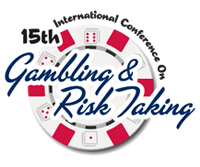Presentation Type
Event
Location
Caesars Palace, Las Vegas Roman Ballroom
Start Date
29-5-2013 10:00 AM
End Date
29-5-2013 10:30 AM
Disciplines
Gaming and Casino Operations Management | Mental and Social Health | Psychology | Public Affairs, Public Policy and Public Administration | Sociology | Statistics and Probability | Substance Abuse and Addiction
Abstract
Context of the study
Pathological gambling prevalence in the general population: United States 0.42% (Petry et al., 2005), Canada 0.5% (Rush et al., 2008), Quebec 0.7% (Kairouz et al., 2011)
Epidemiological surveys (i.e. NESARC) indicate that pathological gambling is usually accompanied by other comorbid disorders, such as: Alcohol and drug abuse (prevalence of 25 and 27%, respectively), alcohol and drug dependence (48 and 11%), mood disorders (50%), anxiety disorders (41%), personality disorders (61%). (Petry et al., 2005)
The comorbidity found in clinical samples is usually higher than that in the general population because it is more likely for a person to seek professional help when presenting more symptoms or more psychiatric disorders compared to individuals with only one condition or a less severe problem. (Petry et al., 2005)
Importance of assessing the prevalence of comorbid disorders in pathological gamblers in treatment, in order to better address their needs and reduce the risk of recurrence.
Included in
Gaming and Casino Operations Management Commons, Psychology Commons, Public Affairs, Public Policy and Public Administration Commons, Sociology Commons, Statistics and Probability Commons, Substance Abuse and Addiction Commons
Mid-morning Break and Poster Sessions: Comorbidity among pathological gamblers seeking treatment
Caesars Palace, Las Vegas Roman Ballroom
Context of the study
Pathological gambling prevalence in the general population: United States 0.42% (Petry et al., 2005), Canada 0.5% (Rush et al., 2008), Quebec 0.7% (Kairouz et al., 2011)
Epidemiological surveys (i.e. NESARC) indicate that pathological gambling is usually accompanied by other comorbid disorders, such as: Alcohol and drug abuse (prevalence of 25 and 27%, respectively), alcohol and drug dependence (48 and 11%), mood disorders (50%), anxiety disorders (41%), personality disorders (61%). (Petry et al., 2005)
The comorbidity found in clinical samples is usually higher than that in the general population because it is more likely for a person to seek professional help when presenting more symptoms or more psychiatric disorders compared to individuals with only one condition or a less severe problem. (Petry et al., 2005)
Importance of assessing the prevalence of comorbid disorders in pathological gamblers in treatment, in order to better address their needs and reduce the risk of recurrence.


Comments
File: Poster